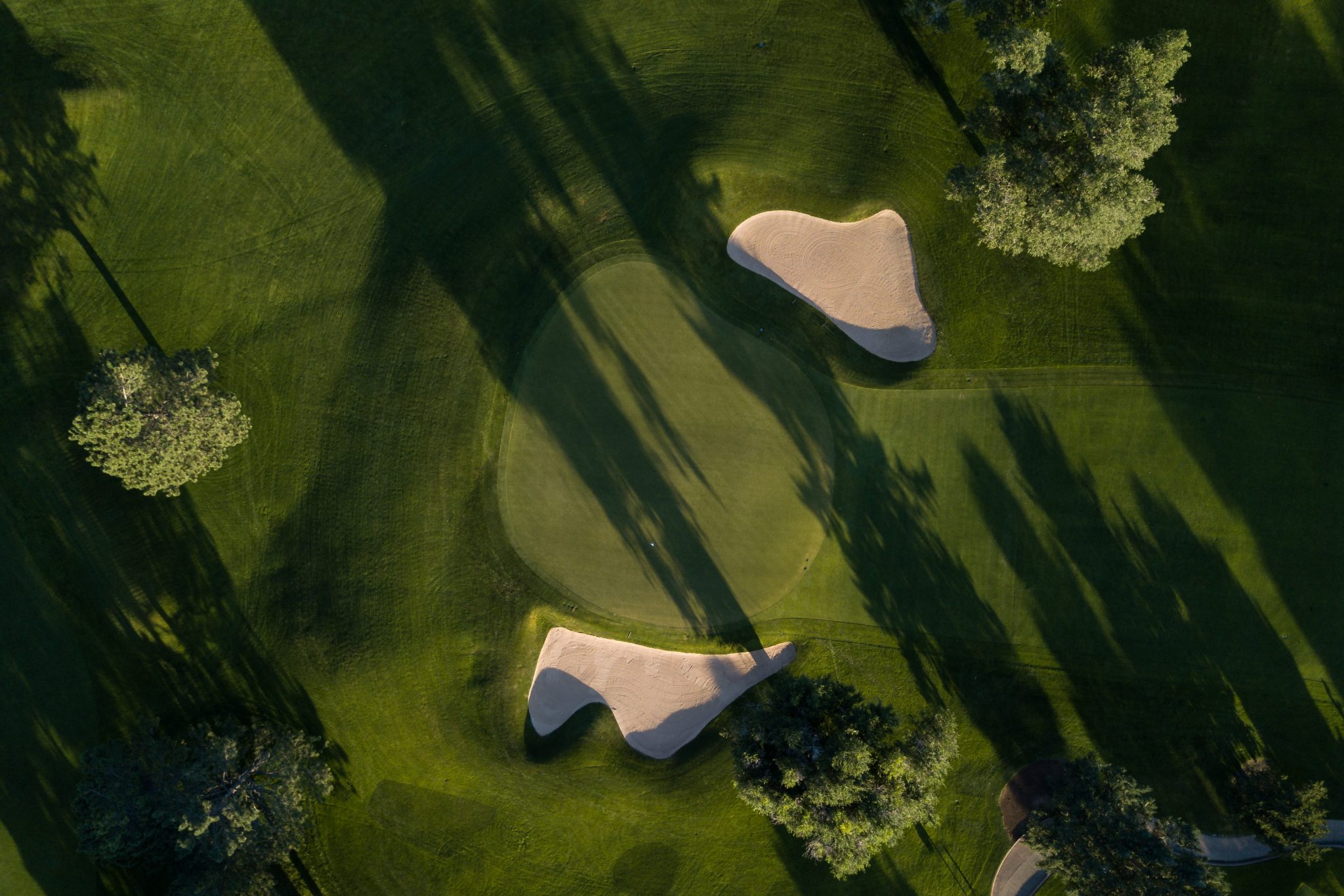Each golf course consists of several golf courses. A course, that is a hole. Usually a golf course has 18 holes, but there are also so-called short courses that only have 9 holes.
Table of Contents
The darn nine
A scorecard from St. Andrews from 1764 documents that 22 holes were played at that time. It was not until some time later that the number of golf courses was reduced to 18 and was laid down in the rules as a fixed unit for a round. Since half a round of new holes is included, the number of holes is always divisible by nine. Just as there are courses with 9 holes, there are also larger courses with 27 or 36 holes.
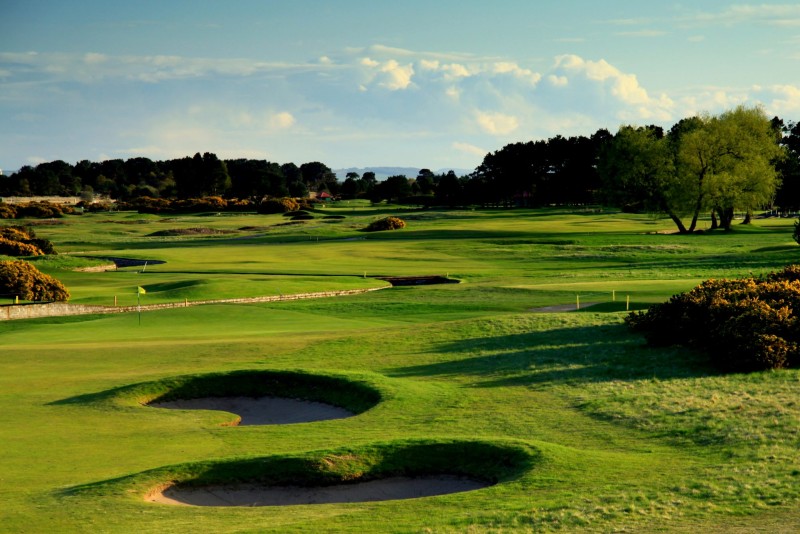
Seen one, seen ’em all?
All golf courses are built according to a similar pattern and have identical facilities. For practising there is the driving range (for long shots), the chipping or pitching green (for short shots) and the putting green (for practising putting). There may also be several short courses (short course), on which you can play without a license to play.
Other elements on a golf course are the bunkers (holes filled with sand), water hazards (ponds, watercourses) and of course the rough (longer grass to unmaintained terrain), which is located at the edge of the fairway.
A typical golf course needs about 60 to 90 hectares for 18 holes, with a length of about 5,000 to 6,600 meters. In the meantime, smaller courses – 9 holes, 6 holes or even 3 holes – are often built, which are often used by golfers who do not have much time.
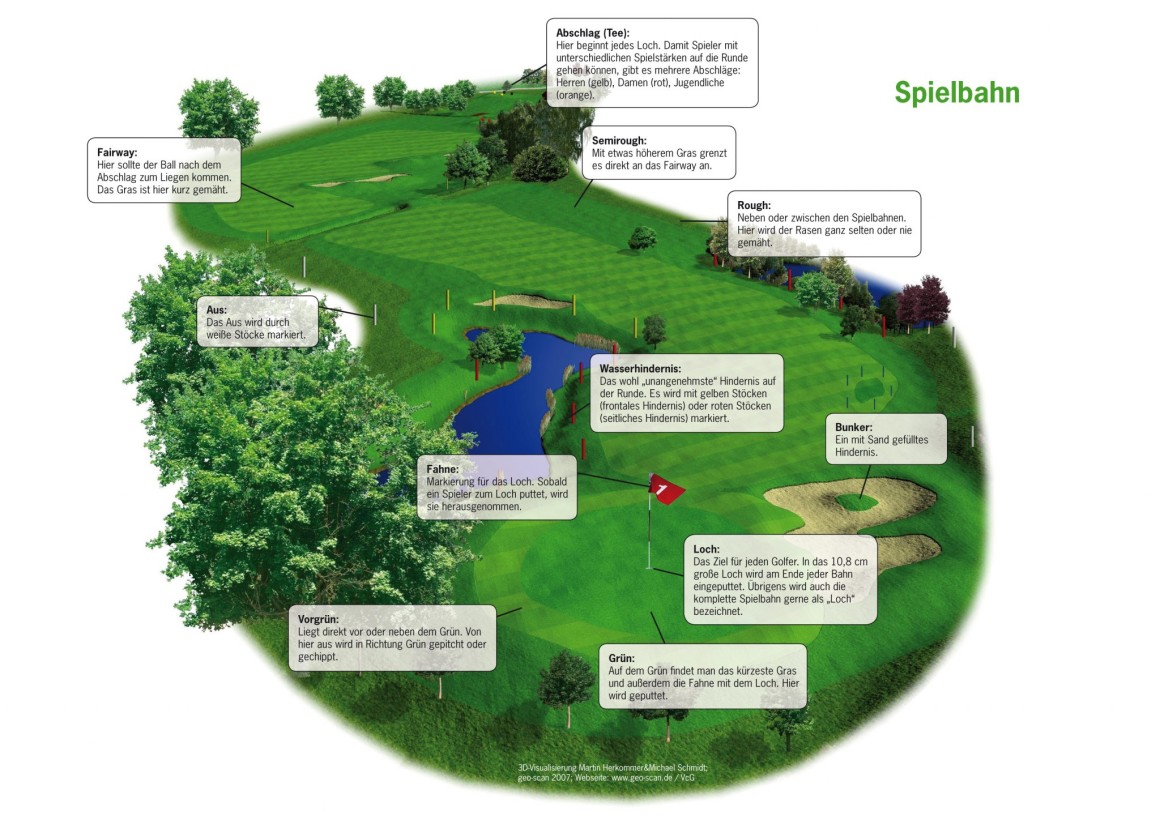
In addition, every club has a clubhouse with sanitary facilities, changing rooms and the so-called 19th hole, a restaurant. The secretariat and the pro-shop (shop for golf articles) are also usually located in the clubhouse. For newly established golf courses, a container house or a garden house often serves as a temporary clubhouse.
Other buildings are used to house lawn mowers and golf carts (electric cars for golfers. Finally, a golf course also includes a parking lot, which is sometimes divided into areas for members and areas for guests.
Each golf course begins with the area for teeing off. This is followed by the fairway. At the end of the fairway follows the green. On the green is the hole with the flag. Since each area, tee, fairway and green, must have different characteristics, different types of turf are used. The greens are always the shortest reviled, because here the ball must be able to roll cleanly.
The thing about the PAR
The distribution of the holes and the obstacles, for example sand bunkers and ponds, is carried out by the golf course architect, whose imagination knows no bounds – but he must always adhere to the guidelines of par 3, par 4 and par 5. “Par” stands for the standard number of strokes required by an experienced golfer to sink the ball into the hole. The length of the holes is also fixed: Courses up to 229 metres are par 3, between 230 and 430 metres long are par 4 and courses over 431 metres are par 5.
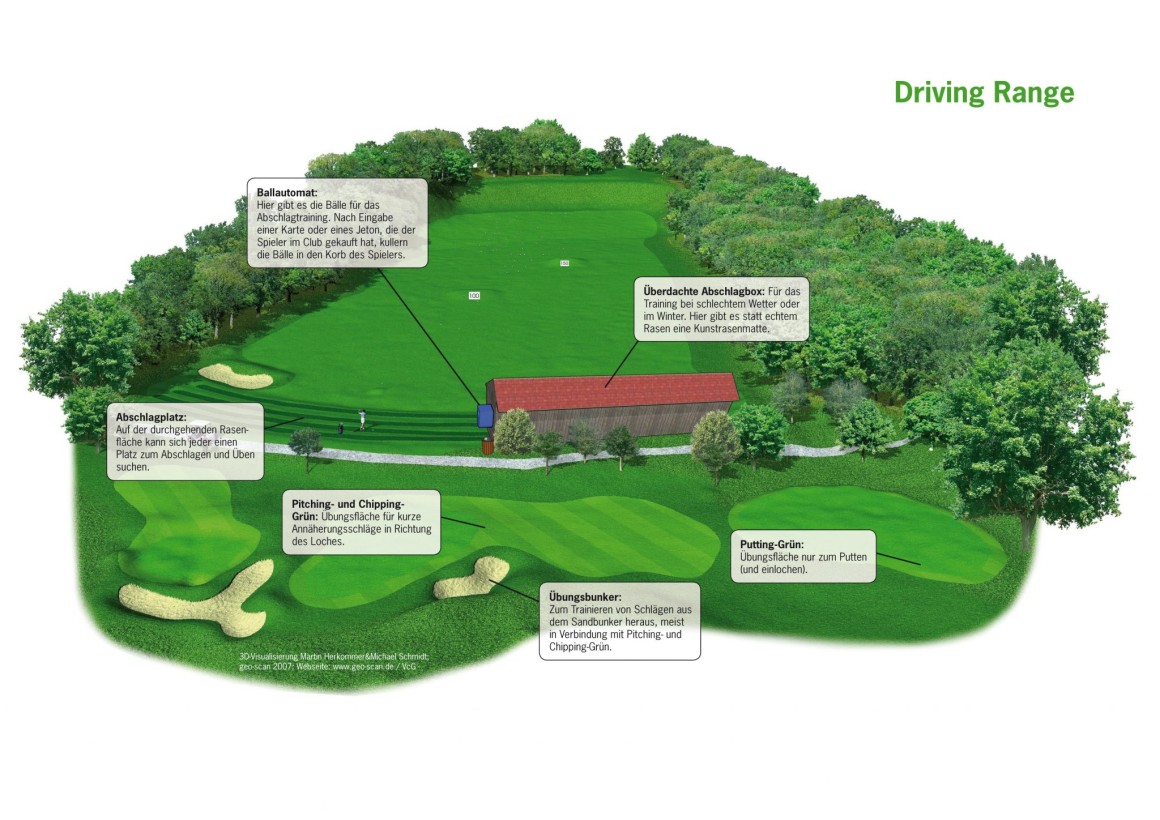
The tee shot
A tee shot is a component of a golf course (tee or tee box). It is a flat, mostly rectangular and often slightly elevated grass surface. Within this area, a tee mark indicates where the ball must be hit (either at the level of the mark or up to two club lengths behind it).
To tee off, the golf ball is often placed on a small pin, the so-called tee. This lifts the ball off the ground and hits it practically “volley”, making longer shots possible. This also reduces the probability of the club hitting the ground incorrectly.
A golf course in Germany usually has four different tees per fairway: a ladies’ tee (red), a men’s tee (yellow), a tournament tee for ladies (black) and a tournament tee for men (white). The tournament tees are further away from the green than the normal ones, the same is usually true for the men’s tees compared to the ladies’. In other countries other colours are sometimes used and there are, especially in the USA, up to six or more tees. The idea here is that every player should play from the tees that correspond to his playing ability, i.e. neither under- nor over-exerting him.
When hitting the ball, damage is often caused to the teeing area, so-called divots. This damage to the turf is repaired by reseeding and fertilising, but the player is required to put the turf back. To ensure that the turf is loaded evenly, the tee markings within the teeing area are moved regularly. This means that the length of the individual fairways can vary by a few metres from day to day.
Tee-offs account for about 2% of the total area of a golf course and the grass is cut to a height between 5 and 10 mm.
The fairway
The fairway is the short mowed area of a fairway between the tee and the green and thus represents the largest part of a golf course in terms of area. Fairways can be straight or have up to two doglegs. Occasionally a fairway is interrupted by ditches, paths, rough areas, lakes or other elements that need to be played over.
The area between the fairway and the surrounding unmown area is called the “semirough”. Although this area is mowed regularly, the grass is higher than on the fairway and therefore demands a technically more difficult golf shot.
For technical reasons the fairways are often equipped with bunkers at strategic points. Since shots from the sand are almost always significantly shorter than those from the fairway, these fairway bunkers are unpopular with many golfers. They are therefore usually so far away from the tee that a worse player cannot reach them at all. A better player who can hit an appropriately long tee shot is expected to master the special technique of hitting from the fairway bunker.
Most modern golf courses have drainage below the turf and irrigation systems for fairways and greens. Water consumption in southern countries is around 10 litres per square metre and is criticised by some environmentalists as a waste of valuable natural resources. However, sometimes golf courses are deliberately not watered, for example in the run-up to a professional tournament (mainly major tournaments), when particularly difficult playing conditions are to be created.
Fairways account for about 23% of the total area of a golf course, and the grass is cut to a height of between 8 and 12 mm.
The Green
The area of a single green is about 300 to 1000 m², with an average of about 550 m². The green is cut and watered daily in summer, and in winter it is closed during frost, otherwise damage may occur. In this case, sometimes replacement greens, the so-called winter greens, are laid out on the fairway.
The speed that a ball reaches when rolling over the green is measured with a Stimpmeter. This is a standardised rail from which a ball is rolled onto the green. The number of feet the ball travels is then the speed of the green.
In order to make the green more difficult, the golf architect has installed so-called “breaks”. This means that the green is not flat, but has small elevations and hollows. This is called a more or less strongly undulating green. The ball does not roll straight ahead there, but is deflected by the breaks and also changes its speed differently than on a flat surface. Accordingly, when putting, you have to aim next to the hole so that the ball rolls in a curve to the target. The calculation of this curve is called “reading the green” and it requires a lot of experience. Professional players get help from their caddies.
The transition from the green to the fairway or rough is called the semigreen. Here the grass is slightly higher than on the green, but you can usually still putt the ball. There are often obstacles around the green that are designed to “defend the green” (make it difficult to get a pass). These are often sand bunkers, which can be extremely deep, but water hazards are also common. If the green is surrounded by water on at least three sides, it is called an island green. Normally one enters such a green over a bridge, in rare cases even a small boat trip is necessary.
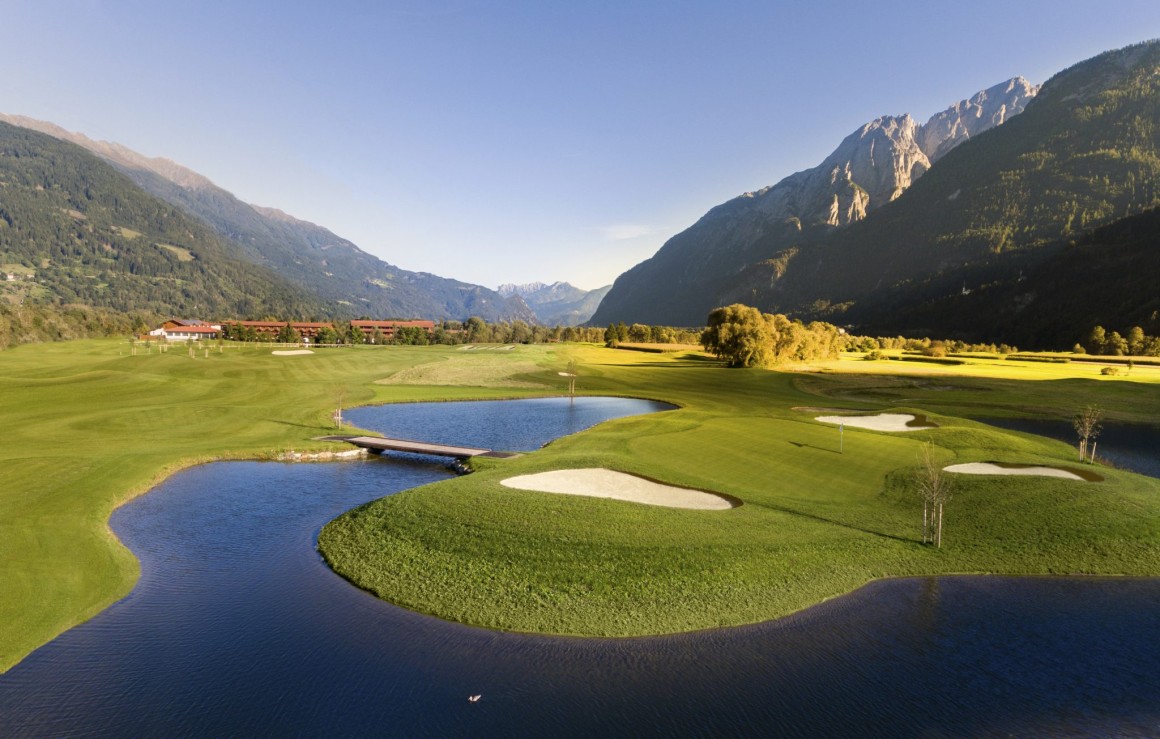
Greens are the most sensitive and expensive parts of a golf course due to their extremely short and even cut. For this reason, golfers are urged to take special care of the green. Damage caused by the ball is repaired with the help of a pitch fork. Underneath the turf there is a 20 cm thick grass base layer consisting of sand and topsoil. This granular base layer is intended to allow surface water (rain or sprinkler system) to seep away. If this drainage does not work, the green can become so soft that golfers leave footprints, making the green unplayable.
Greens make up about 2% of the total area of a golf course, the grass is cut to a height between 2.5 and 3.2 mm during professional tournaments, in everyday use it can be 4 mm.
The Hole
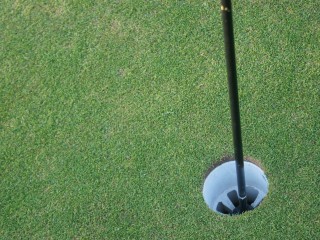
In golf, a hole is the target of a fairway into which the ball is to be played.
A hole is a standard cylindrical metal sleeve at least 10 cm (4 inches) deep with a standard diameter (108 mm, or 4.25 inches). Inside this sleeve is a flag to mark the hole on the green. The flag is removed for putting in the hole.
A green should have several holes and thus allow for several flag positions, since this way it is loaded more evenly and also offers more variety to the players. The holes that are currently not used are covered by the greenkeeper so that the ball can roll over them without any problems. Normally the greenkeeper moves the flag to a different hole every morning. In multi-day tournaments, the flag positions usually become more difficult to play from day to day.
A fairway is also called a “hole” in golf and the bar in the clubhouse is jokingly referred to as the “19th hole”.
The rough
The parts of a golf course that lie between the fairways are called the rough. The rough areas are only mowed twice a year and otherwise left in their natural growth. They are used once to visually delimit the course, so that the golfer ideally gets the feeling of moving alone in the great outdoors. The rough, especially if it contains trees and high bushes, is also important as a safety buffer, as it stops devious balls that could otherwise endanger players on the adjacent fairway or walkers outside the golf course. Finally, the rough also serves as an ecological compensation area for plants and animals. If the rough is particularly high (knee-high to waist-high), it is also known as the hard rough, and a golf shot is then often no longer possible.
The transition area between fairway and rough is the semirough. It is mowed regularly, but the grass is higher than on the fairway, so that slightly warped balls are stopped by it and found in a reasonably playable position. On rare occasions, there are two semi-rough areas between the fairway and the rough. These are also called the “first cut” and “second cut”, where the “first cut” has a cut height between the fairway and the “second cut”.
Depending on the type of rough, it can be very difficult or impossible to find a ball hit there. Since the rules of golf allow up to five minutes of searching time and most players stray off the fairway several times per round, a lush rough can slow down the pace of play enormously. This in turn reduces the possible number of players and thus the revenue per time unit. For this reason, commercially oriented golf course operators are increasingly going to mow the rough frequently or even eliminate it altogether. In such cases, the safety buffer can be realised, e.g. by means of backfill measures along the fairways.
The rough accounts for about 70% of the total area of a golf course.
The Bunker
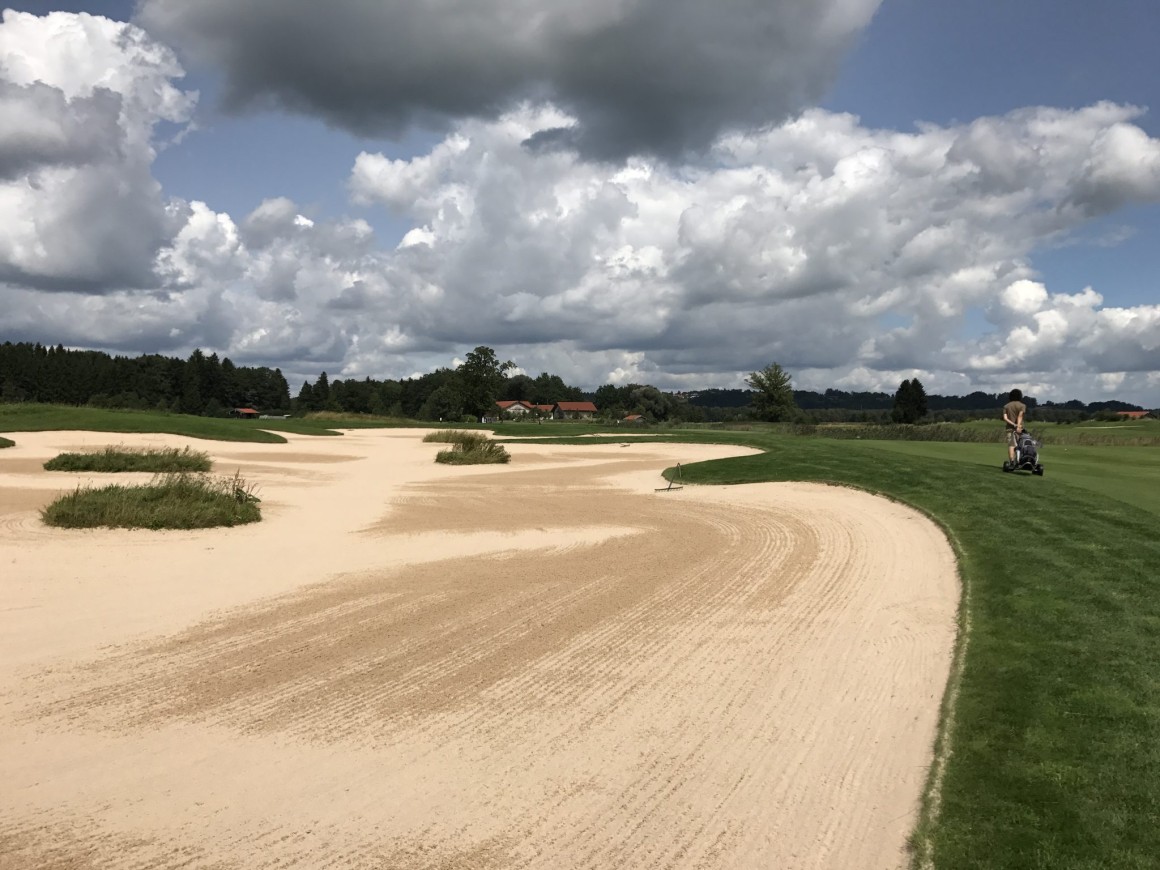
Green bunker on the 18th green of Barbaroux Golf Course, Southern France bunker is a pit, usually filled with sand, which has the special status of an obstacle in the golf rules. Due to technical difficulties, shots from an obstacle are very demanding, especially for average and bad players. After the ball has been hit out of the bunker, the resulting unevenness must be levelled out again with a rake lying on the side.
Deep cavities filled with grass or earth are often called grass bunkers, but on most courses they are not bunkers in the sense of the golf rules, but normal terrain. In addition, there are, especially in desert regions, large sandy areas, which are also not designated as bunkers in the course rules, but as “waste areas”.
To make the bunkers visible from a distance, their backs are usually raised. However, there are also bunkers that are practically invisible, but this is rejected by some golf architects as unfair. However, what often happens when the ball is inside the bunker is an obstruction to the view and path towards the green.
Fairway bunkers are located to the left and right of the fairway and are level with the landing zone of better players’ tees. They usually have a flat edge (also called lip), because you have to make a long, relatively flat shot from them.
Green bunkers are located directly in front of, next to or behind the green to make it more difficult to play, i.e. to defend the green. They are usually deeper than fairway bunkers, since a short, high shot is required here.
Particularly feared are the so-called pot bunkers, which lead steeply and narrowly down, often with stairs or ladders. An old Scottish saying says that in a bunker there only needs to be enough room for an angry man and his niblick (forerunner of the 9 iron).
Followers of the punishing design philosophy liked to place bunkers in the middle of the fairway, i.e. exactly on the ideal line. Today’s golf architects, however, take a more strategic approach. As often as possible, the player should have several options: high risk on the direct path or low risk on a longer path towards the green. Bunkers are then an effective means of modelling this risk/benefit ratio.
The sand used for bunkers is usually a bright quartz sand that glows from a distance. However, crushed marble is also used on particularly demanding golf courses. Under the sand there is often a drainage system to drain standing water in the bunker.
The water hazard
As the name suggests, the water hazard on a golf course is an obstacle in the sense of the golf rules. It is a marked out area, with the boundary posts being coloured either yellow (frontal water hazard) or red (lateral water hazard). Typically, but not necessarily, the area contains a shore zone and water. The water is in the form of a lake or a stream, which can also dry out at certain times of the year.
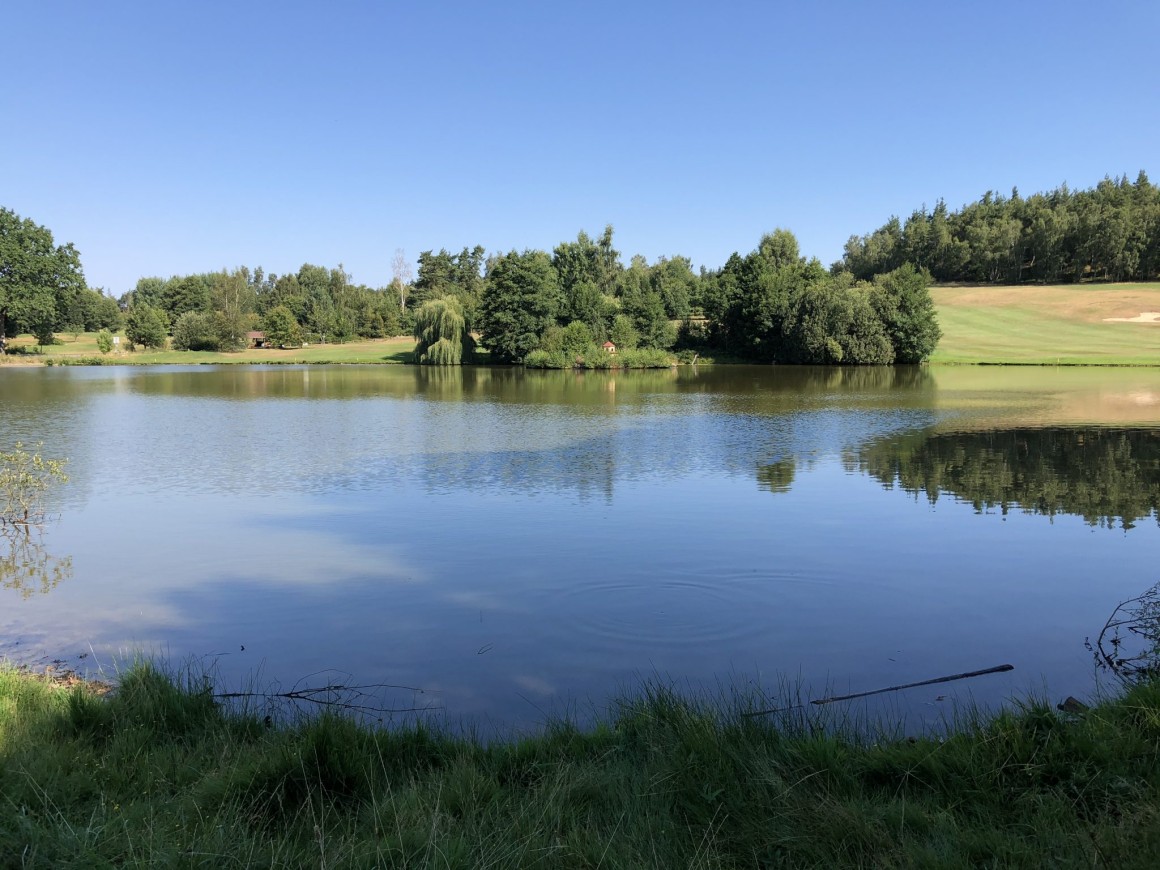
As with the bunker, there are control difficulties with the stroke, but in many cases the ball must be given up from the outset because it is “wet” (in the water). For this reason, professional players are more afraid of water hazards than amateurs do, as very good players can make a passable rescue shot from almost any position, but not if the ball is submerged in water. Due to this high risk factor, golfers always try to keep a certain distance to a water hazard, so that they also provide excellent safety buffers.
Artificial lakes also serve as water reservoirs for a golf course. If some of these reservoirs are evenly distributed over the terrain, the construction of an irrigation system results in short distances for the hoses or pipes to be laid underground.
Water obstacles also represent a source of income for ball collectors. With the help of diving equipment or nets stretched below the water surface, sly balls can be recovered. These balls come on the market as “Lakeballs” in different quality and price gradations depending on their condition.
The golf course layout
How the holes are arranged is called the routing of the golf course. The layout describes how the individual holes are designed or, more generally, how the golf course is integrated into nature.
Traditional Routing
Historically, in the construction of golf courses, the first 9 holes led away from the clubhouse (“out”) to a maximum distance from the golf course. There one turned around and played 9 holes back (“in”) to the clubhouse. The term “out” for the first 9 holes and “in” for the second 9 holes can still be found on the scorecards of the golf courses today. The background for this “in” and “out” model was that you should play 9 holes into the wind and 9 holes with tailwind. As golf has also developed on the windy coasts of Scotland, the prevailing wind directions were an important factor in planning the routing.
Modern Routing
Today, however, the clubhouse is often located in the middle of the golf course, so that a loop of 9 holes can begin and end there. This gives you the opportunity to decide every two hours (which corresponds to the approximate playing time for 9 holes) whether 9 holes are enough or whether you want to play a full round of golf. With clever planning, 27 holes, i.e. three 9-hole loops, can be built around a clubhouse. This has the advantage that you can hold a tournament on 18 holes and still have 9 holes available for players who do not participate in the tournament.
Golf courses in Germany
The number of golf courses in Germany (here an overview) has increased in the past year. Twelve new members admitted the association from 2015 to 2017, bringing the total number of golf courses to 859. Five new golf courses mean 732 playing possibilities nationwide. Here is an overview of the golf courses in Bavaria and Baden-Württemberg as well as an overview of the golf courses in the Münsterland region.
Golf courses and environmental protection
More and more often you can also see deliberately unspoilt nature such as wildflower meadows and dead trees on golf courses. In addition, it is not only suspended nesting and bat boxes and insect hotels that bear witness to the golfers’ new awareness of nature conservation: “Golf courses today are important ecosystems and landscape conservation areas where endangered animal and plant species find a new, undisturbed home,” says VcG Managing Director Marco Paeke. Dr. Gunther Hardt, Chairman of the “Environmental and Course Maintenance Committee” of the German Golf Association (DGV), confirms: “Thanks to golf courses, we have around 50,000 hectares of land in Germany, which offer enormous potential for environmental and nature conservation”.
Species diversity
The golf course has long since ceased to be regarded as an environmental sin that is damaging to the landscape. The focus has shifted to the benefits of the approximately 730 golf courses throughout Germany for nature and mankind: according to experts, an 18-hole course binds around 500,000 tons of dust per year and produces oxygen for 7,000 people. Including infrastructure (clubhouse, parking lot, etc.), it covers an area of around 50 to 70 hectares. Intensively maintained fairways, tees and greens make up about half of this area, but the other part is left in its natural state. These are woodland, semi-natural waters and the areas between the fairways, the roughs. They remain untouched by pesticides and fertilizers and offer protection to animals and plants. “From the wild growth of the rough to the four millimetre grass of the greens, meadows and hedges to the high forest – on the golf course you will find the most diverse landscape structures,” says Dr. Gunther Hardt. “This enables a richness of species that is not found in any other sport. Golf courses offer more habitat than agricultural areas. They are therefore indirectly nature conservationists per se. But many courses today are also actively involved in nature conservation.”
The environmental protection possibilities on golf courses are manifold. These include support measures for wild bees as well as the installation of beehives or orchards. According to Dr. Gunther Hardt, the potential for environmental protection is being increasingly recognised by golf courses. Many cooperate, for example, with regional nature conservation organisations, beekeepers and authorities. “The golfers have the area, the nature conservation associations the know-how – the perfect symbiosis,” the expert says. The result is impressive: Today, the biodiversity on the golf course ranges from endangered locusts and dragonflies, rodents, hedgehogs and other small animals to protected bird and plant species.
Golf courses are by law parks
Considered a public park by the legislator, strict rules apply on the golf course for the use of pesticides: Compared to conventional agriculture, only a fraction of pesticides and fertilizers are used, and natural resources are deliberately protected. For example, many of the facilities today use targeted water management. The use of special sprinkler heads, the measurement of effective evaporation values and modern computer control reduce water consumption to a minimum. In addition, the seeping water is collected and directed into reservoirs on the golf course, which often serve as water obstacles for the golfers. “The prejudice that golfers are destroyers of nature, poisonous splashes and water wasters who drive the animals away with their sport has little to do with reality,” emphasizes Dr. Gunther Hardt.

